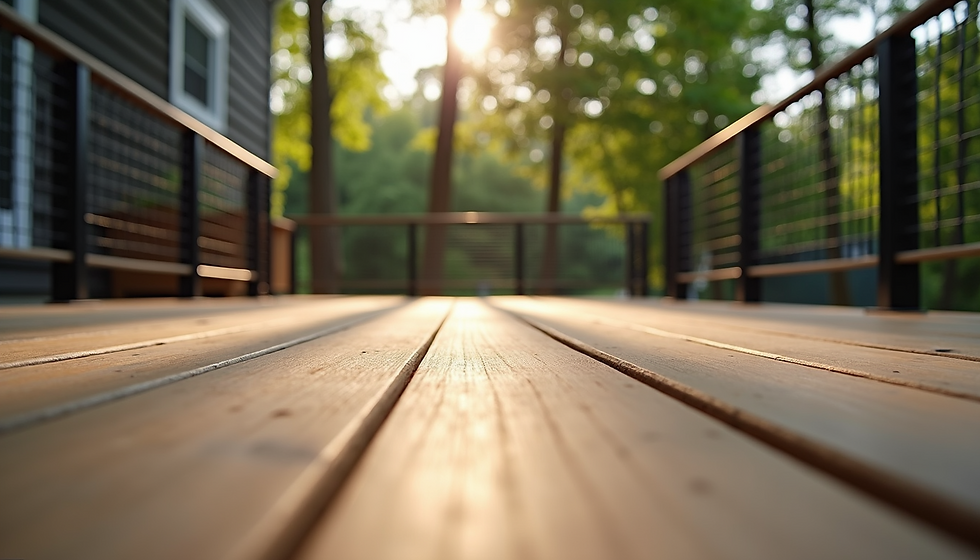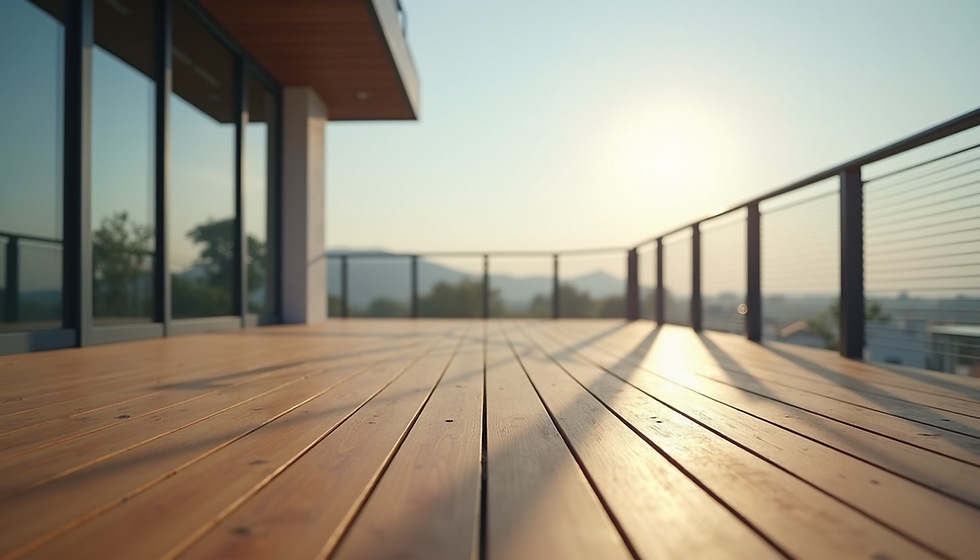Best Tips for Building Durable Decks
- kyle03307
- Jul 23
- 5 min read
Building a deck is an exciting project that can enhance your outdoor living space. A well-constructed deck not only adds value to your home but also provides a perfect spot for relaxation and entertainment. However, to ensure your deck stands the test of time, you need to focus on durability. In this post, we will explore the best tips for building durable decks that can withstand the elements and provide years of enjoyment.
Choose the Right Materials
The first step in building a durable deck is selecting the right materials. The choice of materials can significantly impact the longevity of your deck. Here are some popular options:
Pressure-Treated Wood: This is a common choice for decks. It is treated with chemicals to resist rot and insects. However, it requires regular maintenance, such as staining and sealing.
Composite Decking: Made from a mix of wood fibers and plastic, composite decking is resistant to fading, staining, and mold. It requires less maintenance than wood, making it a popular choice for busy homeowners.
PVC Decking: This is a synthetic option that is completely waterproof and resistant to mold and mildew. It is lightweight and easy to install, but it can be more expensive than wood.
Hardwood: Exotic woods like teak or mahogany are beautiful and durable. They can withstand harsh weather conditions but require regular maintenance to keep them looking their best.
Choosing the right material is crucial for the longevity of your deck. Consider your budget, maintenance preferences, and the climate in your area when making your decision.
Plan for Proper Drainage
Water is one of the biggest enemies of a deck. Poor drainage can lead to water pooling, which can cause wood to rot and promote mold growth. To prevent this, consider the following:
Slope the Deck: Ensure your deck is slightly sloped away from your home. This will help direct water away from the structure.
Install Drainage Systems: If your deck is elevated, consider installing a drainage system underneath. This can help channel water away and keep the area dry.
Use Gutter Systems: If your deck is attached to your home, make sure your gutters are functioning properly. This will prevent water from dripping onto the deck.
By planning for proper drainage, you can significantly extend the life of your deck.
Build a Strong Foundation
A solid foundation is essential for a durable deck. The foundation supports the entire structure, so it must be built correctly. Here are some tips:
Use Concrete Footings: Concrete footings provide a stable base for your deck. They should be placed below the frost line to prevent shifting during freeze-thaw cycles.
Install Posts Properly: Make sure your posts are securely anchored in the footings. Use metal brackets for added stability.
Check for Level: As you build, constantly check that your deck is level. An uneven deck can lead to structural issues over time.
A strong foundation will ensure your deck remains stable and safe for years to come.
Consider the Climate
Your local climate plays a significant role in the durability of your deck. Different materials and construction techniques may be necessary depending on whether you live in a wet, dry, hot, or cold climate. Here are some considerations:
Hot Climates: If you live in a hot area, choose materials that resist fading and heat. Composite or PVC decking is often a good choice.
Wet Climates: In areas with heavy rainfall, opt for materials that resist moisture, such as composite or treated wood. Ensure proper drainage to prevent water damage.
Cold Climates: If you experience freezing temperatures, make sure your foundation is deep enough to prevent frost heave. Use materials that can withstand cold without cracking.
By considering your climate, you can choose the best materials and construction methods for your deck.
Regular Maintenance is Key
Even the most durable decks require maintenance to keep them looking great and functioning well. Here are some maintenance tips:
Clean Regularly: Sweep your deck regularly to remove debris. Use a mild detergent and water to clean the surface at least once a year.
Inspect for Damage: Regularly check for signs of wear, such as loose boards or rusted nails. Address any issues promptly to prevent further damage.
Seal and Stain: If you have a wood deck, apply a sealant or stain every few years to protect it from moisture and UV rays.
Check for Mold: In humid climates, mold can be a problem. Use a mold remover to keep your deck clean and safe.
By staying on top of maintenance, you can extend the life of your deck and keep it looking beautiful.
Use Quality Fasteners
The fasteners you use can impact the durability of your deck. Here are some tips for choosing the right fasteners:
Stainless Steel or Galvanized: Use stainless steel or galvanized screws and nails to prevent rust and corrosion. This is especially important in coastal areas where salt can accelerate corrosion.
Decking Screws: Choose screws specifically designed for decking. They provide better holding power and are less likely to pop up over time.
Avoid Using Regular Nails: Regular nails can loosen over time, leading to structural issues. Always opt for screws for a more secure hold.
Investing in quality fasteners will help ensure your deck remains sturdy and safe.
Design for Longevity
The design of your deck can also impact its durability. Here are some design tips to consider:
Avoid Overhangs: While overhangs can be aesthetically pleasing, they can also trap water. Keep overhangs to a minimum to allow for proper drainage.
Use Proper Spacing: Ensure there is enough space between deck boards for water drainage. A gap of 1/8 to 1/4 inch is typically recommended.
Incorporate Shade: If possible, design your deck with shaded areas. This can help protect the surface from UV damage and keep it cooler in hot weather.
A well-thought-out design can enhance the durability of your deck and make it more enjoyable to use.
Seek Professional Help When Needed
While many homeowners can tackle deck building as a DIY project, some aspects may require professional help. If you are unsure about any part of the process, consider hiring a professional. Here are some reasons to seek help:
Complex Designs: If your deck has a complex design or multiple levels, a professional can ensure it is built safely and correctly.
Building Codes: Professionals are familiar with local building codes and can ensure your deck meets all regulations.
Time Constraints: If you have a busy schedule, hiring a professional can save you time and ensure the project is completed efficiently.
Investing in professional help can provide peace of mind and ensure your deck is built to last.
Final Thoughts on Building a Durable Deck
Building a durable deck is a rewarding project that can enhance your outdoor living space. By choosing the right materials, planning for drainage, building a strong foundation, and maintaining your deck, you can create a space that will last for years. Remember to consider your local climate, use quality fasteners, and design for longevity.
With these tips in mind, you are well on your way to creating a beautiful and durable deck that you and your family can enjoy for many seasons to come.




Comments